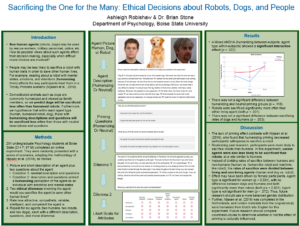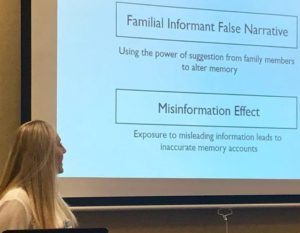Below are example publications and presentations sorted by topic area (*=undergraduate student):
- A.I., Misinformation, Social Media, and Analytical Thinking
- Design, Accessibility, and Teaching/Learning
- Aphantasia and Mental Imagery
- Perception and Action
- Tool Use
- Other
Artificial Intelligence, Misinformation, Social Media, and Analytical Thinking
- [Publication] Stone, B. W. (2025). Generative AI in higher education: Uncertain students, ambiguous use cases, and mercenary perspectives. Teaching of Psychology. https://doi.org/10.1177/00986283241305398 [PDF]
- [Presentation] Stone, B. W. (2024). Training ethical and skilled use of AI as a tool. Talk presented at the Rocky Mountain Psychological Association, Denver, CO, USA.
- [Grant, P.I.] Stone, B. W. (2024-2025). AI Innovation Partnership Grant. BSU College of Innovation and Design.
- [Grant, P.I.] Stone, B. W. (2024-2025). Misinformation and values: Does priming different values affect content moderation preferences. Institute for Advancing American Values.
- [Grant, P.I.][Fellowship] Stone, B. W. (2024-2025). AI Research Fellowship. Boise State University eCampus Center.
- [Presentation] Stone, B. W. (2024). Uncertainty and AI: Data on ethics, inequality, and need for training. Poster presented at the Association for Psychological Science, San Francisco, CA, USA. [Univ. Press Release]
- [Presentation] Stone, B. W. (2024). Working and learning with A.I.: Behaviors, Ethics, and Inequalities. Talk presented at the STP Annual Conference on Teaching, USA.
- [Grant, P.I.][Fellowship] Stone, B. W. (2024). Fellow and Wiki Scholar. Idaho OPAL Fellowship.
- [Grant, P.I.][Fellowship] Stone, B. W. (2023-2024). Learning with artificial intelligence. ECC Faculty Research Fellowship.
- [Award][Presentation] Stone, B. W. (2023). Generative artificial intelligence: Promises and pitfalls for learning. Talk presented at the APA PsychTerms Conference, USA. [Conference award for talk]
- [Presentation] Stone, B. W., & *Brown, B. (2022). Analytical thinking, social media usage, and discernment of fake from real news: What predicts performance? Presented at the Rocky Mountain Psychological Association, Salt Lake City, UT, USA.
- [Presentation] *Brown, B., & Stone, B. W. (2022). Swiping fast and thinking fast: TikTok usage is correlated with heuristic thinking. Presented at the Rocky Mountain Psychological Association, Salt Lake City, UT, USA.
- [Publication] Spezzano, F., Shrestha, A., Fails, J. A., & Stone, B. W. (2021). That’s fake news! Investigating how readers identify the reliability of news when provided title, image, source bias, and full article. Proceedings of the ACM: Human Computer Interaction, 5, 1-19. https://doi.org/10.1145/3449183 [PDF]
- [Op-Ed] Ashley, S., & Stone, B. W. (2021, Sep 24). Idaho needs media literacy to combat COVID-19 misinformation. Idaho Capitol Sun. https://idahocapitalsun.com/2021/09/24/idaho-needs-media-literacy-to-combat-covid-19-misinformation/
- [Presentation] Shrestha, A., Spezzano, F., Fails, J. A., & Stone, B. W. (2021). That’s fake news! Reliability of news when provided title, image, source bias and full article. Presented CSCW’21: ACM Conference on Computer-Supported Cooperative Work and Social Computing [virtual].
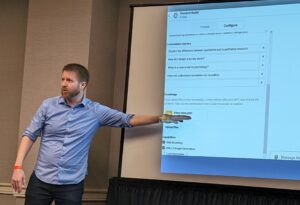
Design, Accessibility, and Teaching/Learning
- [Publication] Stone, B. W., & Brown, D. (2023). Anyone can learn universal design. Journal of Postsecondary Education and Disability, 36(1), 65-74. [PDF]
- [Grant, Co-P.I.] Sydney Boutros, Cindy McCrea, & Stone, B. W. (2023-2024) Enhancing undergraduate student and community learning about neural connectivity through technology-enabled experimentation using the see-one, do-one, teach-one framework. Association for Psychological Science.
- [Presentation] *Perryman, E., *Mong, H., *Manning, C., *Walker, M., *Storey, N., *Echols, E., & Stone, B. W. (2022). Dark patterns: User perceptions. Poster presented at the Undergraduate Research Showcase, Boise, ID, USA.
- [Publication] Stone, B. W., & Brown, D. (2021). Changing attitudes about visual impairment in the college classroom. Journal of Blindness Innovation and Research, 11(1). https://doi.org/10.5241/11-200
- [Publication] Stone, B. W., *Kay, D., *Reynolds, A., & Brown, D. (2020). 3D printing and service learning: Accessible open educational resources for students with visual impairment. International Journal of Teaching and Learning in Higher Education, 32(2), 336-346. https://www.isetl.org/ijtlhe/pdf/IJTLHE3752.pdf [PDF]
- [Presentation] Stone, B. W. (2020). 3D printing for accessibility: Students as makers, collaborators, and leaders. Presented at National Society for Experiential Education, Salt Lake City, UT, USA.
- [Presentation] Stone, B. W. (2020). 3D printed OER for introductory psychology. Talk accepted at TIP Northwest, Des Moines, WA, USA. [Accepted but travel suspended for COVID-19]
- [Presentation] Stone, B. W., & Brown, D. (2020). Accessibility and attitudes in higher ed curriculum. Presented at the Great Ideas for Teaching and Learning Symposium, Boise, ID, USA.
- [Publication] Stone, B. W., *Kay, D., & *Reynolds, A. (2019). Teaching visually impaired college students in introductory statistics. Journal of Statistics Education, 27(3), 225-237. https://doi.org/10.1080/10691898.2019.1677199 [PDF]
- [Presentation] Stone, B. W. (2019). A project-based service learning course creating 3D-printed models for blind and visually impaired learnings: A model for changing attitudes and integrating accessibility into the psychology curriculum. Presented at the Rocky Mountain Psychological Association, Denver, CO, USA.
- [Presentation] *Babuata, A., & Stone, B. W. (2019). Can media depictions change attitudes toward people who are blind or visually impaired? Presented at the Idaho Conference on Undergraduate Research, Boise, ID, USA.
- [Grant, P.I.] Stone, B. W. (2018). Teach Access Grant. Silicon Valley Community Foundation.
- [Grant, P.I.] Stone, B. W. (2018). APS Small Grant Program. Association for Psychological Science.
- [Presentation] Brown, D., & Stone, B. W. (2018). 3D printed models: An opportunity for deeper understanding for all. Presented at the Success Through Access conference, Boise, ID, USA.
- [Grant, Collaborator] Department of Psychological Science, Stone, B. W. (2017). Evidence-based Instructional Practices. NSF WIDER-PERSIST grant.
- [Book Chapter] Amlung, M., Simpson, E. A., Dengler, M., Stone, B. W., *Williams, G., & Domizi, D. (2016). With a little help from my friends: The role of peer mentoring in graduate student teaching assistant development. In G. Wright (Ed.), The mentoring continuum: From graduate school through tenure. Syracuse: Syracuse University Press.
- [Presentation] Amlung, M., Dengler, M., Simpson, E., Stone, B. W., *Williams, G., & Domizi, D. P. (2012). The role of peer mentoring in psychology teaching assistant development. Presented at the 120th Convention of the American Psychological Association, Orlando, FL, USA.
- [Fellowship] Stone, B. W. (2010). Future faculty fellow. University of Georgia, Athens, GA, USA.
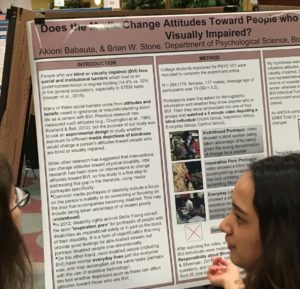
Aphantasia and Mental Imagery
- [Presentation] *McNinch, C., *Watson, C., *Van Sligtenhorst, M. R., *Bukkhegyi, M., *Jacoba, M. J., *Levesque, S. B., & Stone, B. W. (2022). Visualization strategies in the workplace. Poster presented at the Undergraduate Research Showcase, Boise, ID, USA.
- [Presentation] *Levesque, S. R., *Bukkhegyi, M., *Jacoba, M. J., *Watson, C., *Van Sligtenhorst, M. R., *McNinch, C., & Stone, B. W. (2022). Sensory experience in dreams for aphantasics. Poster presented at the Undergraduate Research Showcase, Boise, ID, USA.
- [Presentation] Stone, B. W., *Lyons, C., *Vrapi, B., *Barvo, M., & *Herrera, C. L. (2018). Aphantasia: A life without mental imagery. Presented at the Rocky Mountain Psychological Association, Denver, CO, USA.
- [Presentation] *Lyons, C., *Vrapi, B., *Barvo, M., *Herrera, C., Stone, B. W. (2017). Born blind in the mind’s eye: Investigating congenital aphantasia. Presented at Undergraduate Research Conference, Boise, ID, USA.
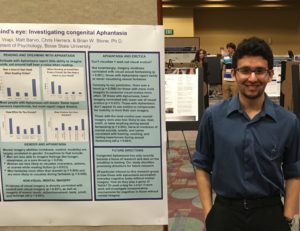
Perception and Action
- [Presentation] *Semko, J., & Stone, B. W. (2018). Seeing is what you hear: Inducing visual hallucinations via Pavlovian conditioning. Presented at the Rocky Mountain Psychological Association, Denver, CO, USA.
- [Presentation] *Semko, J., & Stone, B. W. (2018). Hijacking the predictive brain: Inducing visual hallucinations. Presented at the Undergraduate Research Conference, Boise, ID, USA.
- [Presentation] Stone, B. W. (2017). What determines disruption of afterimages in darkness? Presented at Rethinking the Senses, Dubrovnik, Croatia.
- [Publication] Stone, B. W., & *Tinker, J. (2016). Multisensory tracking of objects in darkness: Capture of positive afterimages by the tactile and proprioceptive senses. PLOS ONE, 11(3), e0150714. https://doi.org/10.1371/journal.pone.0150714 [PDF]
- [Presentation] Stone, B. W., & *Tinker, J. (2014). Auditory feedback of movement alters visual afterimage of an object. Presented at Auditory Perception, Cognition, and Action Meeting, Long Beach, CA, USA.
- [Award][Presentation] Stone, B. W. (2013). Post-human bodies: What sensory psychology tells us about the future of integrating biology and technology. Presented at 13th Annual UGA Interdisciplinary Research Conference, Athens, GA, USA. [People’s Choice Award for best talk]
- [Presentation] Stone, B. W., & *Tinker, J. (2013). ABSTRACT: Capture of positive afterimages by the other senses: Extension of the body schema? Journal of Vision, 13(9), 1327
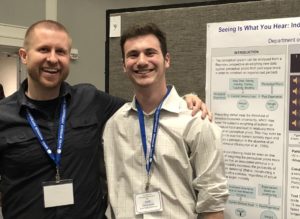
Tool Use
- [Publication] †Fragaszy, D. M., †Kuroshima, H., & †Stone, B. W. (2015). Vision for action in young children aligning multi-featured objects: Development and comparison with nonhuman primates. PLOS ONE, 10(10), e0140033. https://doi.org/10.1371/journal.pone.0140033 †authors contributed equally [PDF]
- [Publication] La Cour, L. T., Stone, B. W., Hopkins, W., Menzel, C., & Fragaszy, D. (2014). What limits tool use in nonhuman primates? Insights from tufted capuchin monkeys (Sapajus spp.) and chimpanzees (Pan troglodytes) aligning three-dimensional objects to a surface. Animal Cognition, 17(1), 113-125. https://doi.org/10.1007/s10071-013-0643-x [PDF]
- [Publication] Fragaszy, D. M., Stone, B., Scott, N. M., & Menzel, C. (2011). How tufted capuchin monkeys (Cebus apella spp) and common chimpanzees (Pan troglodytes) align objects to surfaces: Insights into spatial reasoning and implications for tool use. American Journal of Primatology, 73(10), 1012-1030.https://doi.org/10.1002/ajp.20966 [PDF]
- [Publication] Pan, J., Kennedy, E. H., *Pickering, T., Menzel, C. R., Stone, B. W., & Fragaszy, D. M. (2011). Development of maze navigation by tufted capuchins (Cebus apella). Behavioural Processes, 86(2), 206-215. https://doi.org/10.1016/j.beproc.2010.11.006 [PDF]
- [Presentation] Stone, B. W., Fragaszy, D. M., Scott, N. M., & Menzel, C. (2011). How nonhuman primates align objects to surfaces: The effects of concurrent spatial relations in an object insertion task. Presented at Progress in Motor Control VIII, Cincinnati, OH, USA.
- [Presentation] Stone, B. W., Liu, Q., Jeyarah, T., Sirianni, G., Busch-Dienstfertig, M., Christel, M., Vickers, J., Visalberghi, E., & Fragaszy, D. (2011). Vigilance in capuchin monkeys: Evidence for an endogenous rhythm? Presented at the joint meeting of the International Ethological Conference and Animal Behavior Society, Bloomington, IN, USA.
- [Invited Talk] Stone, B. W. (2010). Space, tools, and body schema. Presented at HOPE Seminar on Tools in Primates, Myoko-Sasagamine, Japan.
- [Grant, P.I.] Stone, B. W. (2010). Grant for invited talk and retreat. International Primatological Society and HOPE Seminar on Tools, Japan.
- [Presentation] Stone, B. W., Jeyaraj, T., & Fragaszy, D. (2010). How do capuchins stack up against chimpanzees and humans? Assessing combinatory manipulation in a block stacking task. Presented at the 33rd International Primatological Society Congress, Kyoto, Japan.
- [Presentation] Menzel, C. R., Menzel, E. W., Kelly, J. W., Chan, B., Evans, T. A., & Stone, B. W. (2008). ABSTRACT: The rank ordering problem in primate foraging. American Journal of Primatology, 70(S1), 64.
- [Presentation] Stone, B. W., Menzel, C. R., Evans, T. A., *Benoit, J., & Fragaszy, D. M. (2008). ABSTRACT: Capuchin monkeys (Cebus apella) learn to point with a laser. American Journal of Primatology, 70(S1), 63.
Other
- [Presentation] *Robishaw, A., & Stone. B.W. (2020). Sacrificing the one for the many: Ethical decisions about robots, dogs, and people. Presented at the Idaho Conference on Undergraduate Research, Boise, ID, USA.
- [Presentation] *Prescott, R., & Stone, B. W. (2019). Memory malleability: Falsifying true memories. Presented at the Rocky Mountain Psychological Association, Denver, CO, USA.
- [Presentation] *Palasch, C., & Stone, B. W. (2019). A predictive model of internet addiction: The role of alienation. Presented at the Idaho Conference on Undergraduate Research, Boise, ID, USA.
- [Presentation] *Barvo, M., & Stone, B. W. (2019). Psychological reasons why college students avoid healthcare. Presented at the American College of Physicians, Philadelphia, PA, USA. [Awarded finalist in poster competition]
